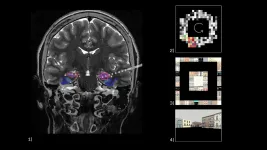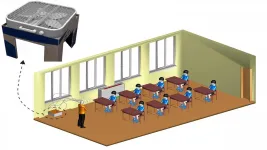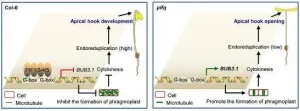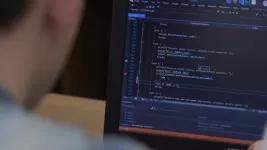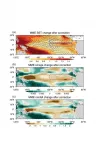New York, NY--May 11, 2021-- For decades the dominant approach to understanding the brain has been to measure how many times individual neurons activate during particular behaviors. In contrast to this "rate code," a more recent hypothesis proposes that neurons signal information by changing the precise timing when they activate. One such timing code, called phase precession, is commonly observed in rodents as they navigate through spaces and is thought to form the basis for how the brain represents memories for sequences. Surprisingly, phase precession has never been seen in humans, and thus its usefulness in explaining brain function and creating brain-machine interfaces has been quite limited.
In a study published today in Cell, Joshua Jacobs, associate professor of biomedical engineering at Columbia Engineering, in collaboration with Dr. Itzhak Fried, a professor of neurosurgery at the David Geffen School of Medicine at UCLA, demonstrate the existence of this neural code in the human brain for the first time, and show that phase precession not only links sequential positions, as in animals, but also abstract progression towards specific goals.
"We were convinced that phase precession held a lot of promise as a widespread neural code that could be used for learning and cognition," says Salman E. Qasim, lead author of the study who received his PhD from Columbia Engineering in 2021. "There's no reason the human brain wouldn't take advantage of this mechanism to encode any kind of sequence, spatial or otherwise."
The researchers analyzed direct brain recordings from neurosurgical patients who performed a virtual-reality spatial navigation task in which they had to find and return to six specific buildings. By identifying an internal clock in the form of low-frequency (2-10 Hz) brain oscillations, the team was able to measure how the relative timing of neuronal action potentials correlated with sequential spatial locations, just as in rodents. And what they found especially exciting was that this temporal code extended beyond only representing spatial location to represent the episodic progress subjects had made towards certain goal locations.
The team was able to measure the activity of single neurons by taking advantage of a rare opportunity: the ability to invasively record from the brains of 13 neurosurgical patients at UCLA. Because these bedridden patients had drug-resistant epilepsy, they already had recording electrodes implanted in their brains for their clinical treatment. They used laptops and handheld controllers to move through virtual environments to complete a spatial navigation task designed by the research team.
As the researchers analyzed the neural data from the patients, they noticed how often neurons seemed to fire in concert with slow brain waves. The team was then able to identify phase precession in the hippocampus as subjects moved through different locations, similar to prior observations in rodents.
"This study demonstrates the unique insights at the level of single brain cells that we may gain in special clinical settings of brain surgery for patients with epilepsy and other disorders," said the study's co-author Fried, director of the epilepsy surgery program at UCLA Health. "Here, a simple task performed by patients unveils a fundamental brain code for human negotiation of their environment."
Knowing now that this temporal code was present for spatial locations in humans, Qasim next looked for evidence that phase precession tracked more complex cognitive sequences, such as the more abstract progress a person had made towards specific goals (i.e. buildings). To do so, the team had to devise a way to measure the temporal relationship between sparse, inconsistent brain-waves and neural spiking without any reference to spatial position. Once they accomplished this, they were surprised to find evidence for phase precession in the frontal cortex, where it has never been observed before, as subjects sought specific goals.
"It is hard to study the neural representations of complex cognitive functions, like goal-seeking, in many animal models. By demonstrating that phase precession in humans might represent particular goal states, this study supports the idea that temporal codes like phase precession could be critical to understanding human cognition," says Sameer Sheth, a leading neurosurgeon and neuroscientist at the Baylor College of Medicine who is not affiliated with the study.
Qasim and Jacobs hope that establishing a precedent for phase precession in humans will guide research into temporal coding as an important aspect of human cognition. By demonstrating the existence of phase precession in multiple brain regions, with respect to multiple aspects of a task, the Columbia Engineering team hopes to open new avenues to decoding brain activity that rely on temporal coding, in addition to rate coding. Furthermore, scientists have theorized that phase precession might be important for memory, as sequence learning is important to ordering events in our memory. In line with this, rodent researchers have primarily observed phase precession in brain circuits disrupted by Alzheimer's disease. As such, the discovery of phase precession may enable researchers to further probe neuronal biomarkers of memory.
Jacobs adds, "We hope to further explore whether phase precession is a universal code throughout the human brain, and for different kinds of behaviors. Then we can begin to better understand how this neuronal coding mechanism can be used for brain-machine interfaces, and manipulated by therapeutic brain stimulation."
INFORMATION:
About the Study
The study is titled "Phase precession in the human hippocampus and entorhinal cortex."
Authors are: Salman E. Qasim1, Itzhak Fried2, and Joshua Jacobs1
1Department of Biomedical Engineering, Columbia University
2Department of Neurological Surgery, University of California, Los Angeles
The study is funded by the National Institute of Neurological Disorders and Stroke R01-NS033221 and R01-NS084017 (to I.F.), National Institute of Mental Health R01-MH104606 and the National Science Foundation BCS-1724243 (to J.J.), and NSF Graduate Research Fellowship DGE 16-44869 (to S.E.Q.).
The authors declare no financial or other conflicts of interest.
LINKS:
Paper:https://www.cell.com/cell/fulltext/S0092-8674(21)00496-7
DOI: 10.1016/j.cell.2021.04.017
http://engineering.columbia.edu/
https://www.engineering.columbia.edu/faculty/joshua-jacobs
https://bme.columbia.edu/
https://www.uclahealth.org/itzhak-fried
https://www.uclahealth.org/neurosurgery/
https://medschool.ucla.edu/
Columbia Engineering
Columbia Engineering, based in New York City, is one of the top engineering schools in the U.S. and one of the oldest in the nation. Also known as The Fu Foundation School of Engineering and Applied Science, the School expands knowledge and advances technology through the pioneering research of its more than 220 faculty, while educating undergraduate and graduate students in a collaborative environment to become leaders informed by a firm foundation in engineering. The School's faculty are at the center of the University's cross-disciplinary research, contributing to the Data Science Institute, Earth Institute, Zuckerman Mind Brain Behavior Institute, Precision Medicine Initiative, and the Columbia Nano Initiative. Guided by its strategic vision, "Columbia Engineering for Humanity," the School aims to translate ideas into innovations that foster a sustainable, healthy, secure, connected, and creative humanity.
